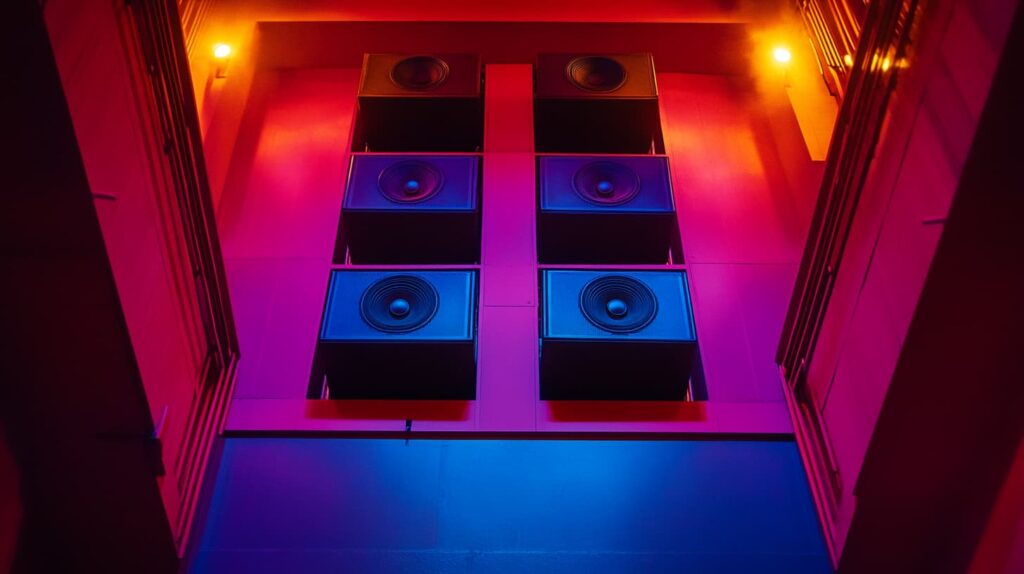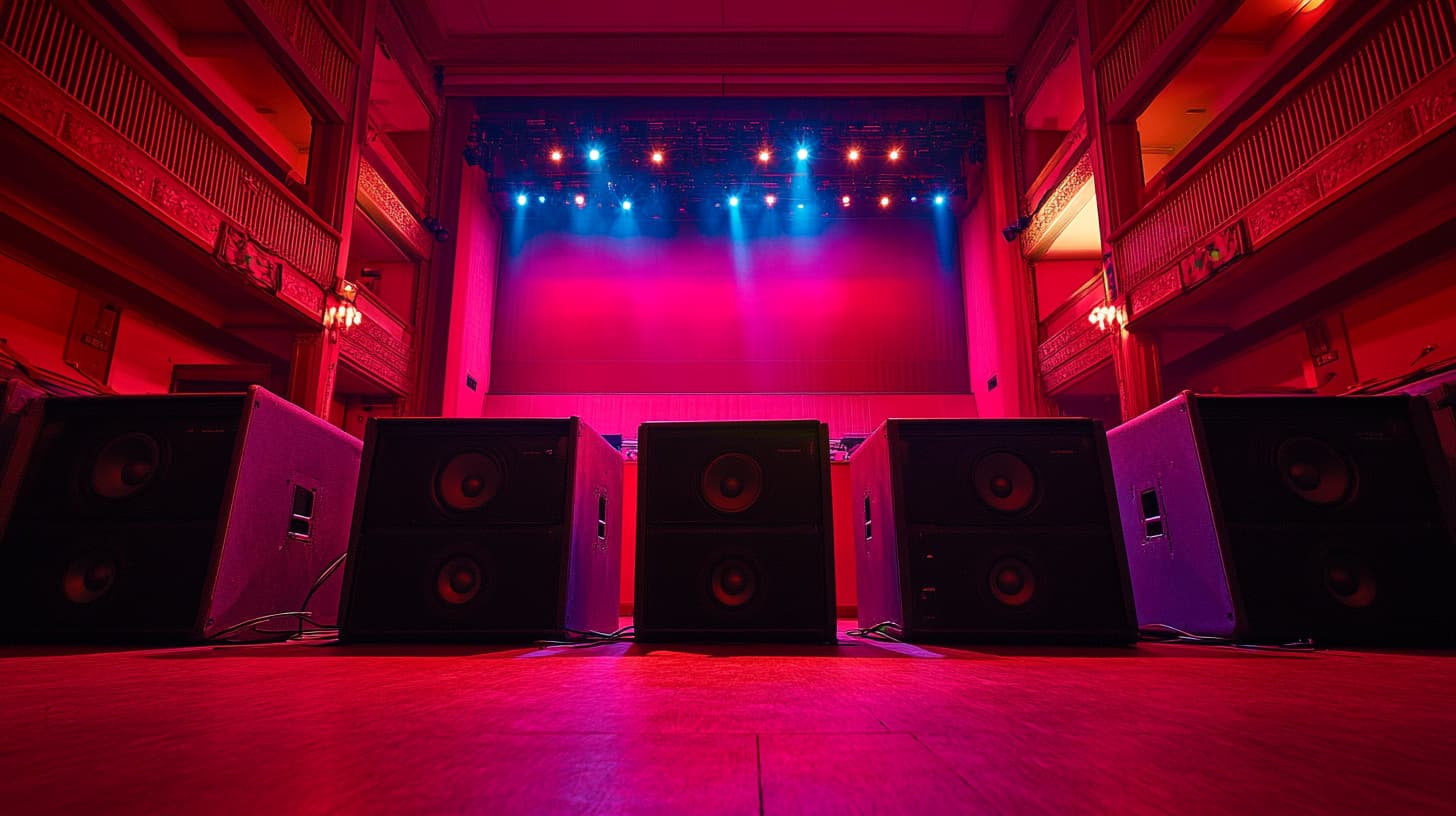Enhancing Theatre Experiences with High-Quality Sound Systems
Recent studies reveal that up to 68% of audience engagement in theatrical performances depends on sound quality. In an era where digital entertainment sets increasingly high standards for audio experiences, theatre sound systems must evolve to meet and exceed audience expectations while honoring the authenticity of live performance.
The Architecture of Audio
Modern theatre sound design begins with understanding the complex relationship between space and sound. Traditional theatre architecture, developed long before electronic amplification, relied on natural acoustic principles to project performers’ voices. While professional sound system installation requires careful consideration of these historical elements, today’s sound systems must work in harmony with architectural features while addressing contemporary challenges and expectations.
Engineering Excellence Through Strategic Installation
The successful implementation of theatre sound systems requires a deep understanding of both acoustic principles and performance requirements. Every space presents unique challenges, from historical theatres with complex architectural features to modern black box spaces designed for maximum flexibility. The key lies in creating systems that enhance rather than overwhelm the natural acoustics of the space.
Measuring Success
Professional theatre sound installation focuses on achieving specific performance metrics that ensure optimal audience experience. Critical factors include:
| Sound Parameter | Performance Space | Target Range | Impact on Experience |
| Coverage Uniformity | Main Seating | ±3 dB | Consistent Experience |
| Frequency Response | Full Range | 40Hz-18kHz | Natural Sound |
| Speech Intelligibility | All Areas | >0.65 STI | Clear Dialogue |
Room Acoustics and Sound Behavior
The interaction between sound systems and room acoustics plays a crucial role in performance quality. Factors such as room shape, surface materials, and audience absorption significantly impact sound behavior. Early reflections, occurring within the first 50 milliseconds after direct sound, can either enhance or degrade speech intelligibility depending on their timing and strength.
Critical System Components
Microphone Selection and Placement
The choice of microphones dramatically affects performance quality. Modern theatrical productions typically employ a combination of:
- Overhead cardioid microphones for ensemble pickup
- Wireless lavalier systems for principal performers
- Boundary microphones for stage area coverage
- Shotgun microphones for precise targeting
Digital Signal Processing (DSP)
Modern theatre sound relies heavily on sophisticated DSP systems that provide:
- Automatic feedback suppression
- Real-time room optimization
- Dynamic range control
- Time alignment between speakers
Environmental Considerations
Temperature and Humidity Effects
Environmental conditions significantly impact sound system performance. Temperature gradients can cause sound to bend, while humidity affects high-frequency propagation. Modern systems must include sensors and compensation mechanisms to maintain consistent performance despite environmental variations.
Power Conditioning
Clean, stable power is essential for professional sound system operation. Proper power conditioning helps prevent:
- System noise from electrical interference
- Equipment damage from voltage fluctuations
- Ground loop issues
- Intermittent performance problems
Maintenance and System Longevity
Preventive Maintenance Protocols
Regular maintenance ensures optimal system performance and longevity. Key maintenance tasks include:
- Monthly speaker inspection and testing
- Quarterly wireless system optimization
- Semi-annual signal chain verification
- Annual complete system calibration
Documentation and Training
Comprehensive system documentation and staff training are crucial for long-term success. This includes:
- Detailed system diagrams and specifications
- Operating procedures for different types of performances
- Troubleshooting guides
- Emergency backup procedures
Budget and Return on Investment
Cost Analysis
Theatre sound system investments typically break down as follows:
- Core system components: 45-50% of budget
- Installation and integration: 20-25%
- Acoustic treatment: 15-20%
- Training and documentation: 10%
Energy Efficiency
Modern systems incorporate energy-saving features:
- Class D amplification for reduced power consumption
- Smart power management for unused components
- LED indicators for reduced heat generation
- Efficient ventilation design
Safety and Compliance
Emergency Integration
Theatre sound systems must integrate with emergency systems, including:
- Fire alarm override capability
- Emergency announcement priority
- Backup power systems
- Multiple evacuation zones
The Psychology of Theatre Sound
Creating effective theatre sound goes beyond simply installing speakers and microphones. It requires understanding how audiences perceive and process audio information in performance spaces. The goal is to create an immersive experience that supports rather than distracts from the theatrical narrative.
Balancing Art and Technology
Modern theatre sound must strike a delicate balance between technological capability and artistic intention. Digital signal processing and automated control systems provide unprecedented flexibility, but their implementation must always serve the fundamental goal of supporting storytelling and emotional connection.
The Technical Symphony
The integration of sound systems into theatrical spaces requires careful coordination of multiple technical elements. Modern installations typically incorporate distributed speaker arrays, sophisticated digital mixing platforms, and networked control systems. These components must work together seamlessly while remaining invisible to the audience.
Infrastructure for Excellence
Proper infrastructure forms the backbone of any successful theatre sound installation. This includes not only the visible components like speakers and control surfaces but also the critical behind-the-scenes elements: power distribution, signal routing, and system monitoring capabilities.
Educational Theatre
Theatre sound systems in educational settings serve dual purposes: supporting performances and providing learning opportunities. These installations must be both sophisticated enough to prepare students for professional work and robust enough to withstand the rigors of educational use.
Training Through Technology
Students working with professional-grade sound systems develop not only technical skills but also an understanding of how technology serves artistic vision. This knowledge becomes increasingly valuable as theatrical productions incorporate more complex sound design elements.
Innovation in Theatre Sound
The future of theatre sound lies in the integration of traditional acoustic principles with emerging technologies. Smart systems that can adapt to changing performance conditions, automated mixing capabilities that enhance rather than replace human operators, and new approaches to immersive audio all promise to further evolve the theatrical experience.

Sustainable Solutions
Modern theatre sound installation increasingly emphasizes sustainability, both in terms of energy efficiency and long-term viability. New speaker technologies offer improved efficiency, while modular system designs allow for easier updates and maintenance.
Practical Considerations for Implementation
The successful implementation of theatre sound systems requires careful planning and execution. Factors to consider include:
Critical Implementation Phases
Space Analysis
- Acoustic measurements
- Architectural evaluation
- Performance requirements
- Budget constraints
System Design
- Component selection
- Integration planning
- Control systems
- Future expansion
The Sound of Success
The implementation of high-quality theatre sound systems represents a crucial investment in the future of live performance. By combining traditional acoustic principles with modern technology, theatres can create immersive audio environments that enhance storytelling and emotional connection while preparing the next generation of theatre artists for success.
The future of theatre sound lies in this careful balance between tradition and innovation. As audience expectations continue to evolve, the role of sophisticated sound systems in creating memorable theatrical experiences becomes increasingly critical. Through thoughtful implementation of modern sound technology, theatres can ensure their continued relevance and impact.
